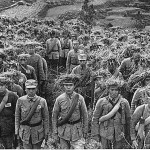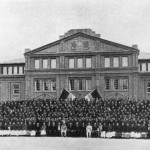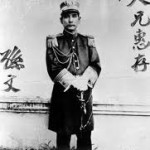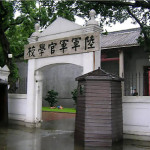
The Guomindang (Wade-Giles: Kuomintang), or Chinese Nationalist Party, was China’s largest revolutionary and republican party – at least until the late 1930s. The Guomindang’s primary mission was to unify China under a republican government. Formed by Sun Yixian and his followers in 1912, the Guomindang was the largest party in both houses of the National Assembly, China’s newly formed legislature. But when autocratic president Yuan Shikai rendered the assembly powerless and dissolved it, he also declared the Guomindang an illegal organisation. Forced into exile, the Guomindang and its leaders launched a 15-year struggle to reunify China and restore a truly republican government. The Guomindang developed its own military arm, the National Revolutionary Army, which finally achieved reunification in 1927-28. Led by Jiang Jieshi, the Guomindang was able to form a national government and rule China – or most of it – until the Japanese occupation in the late 1930s.
The origins of the Guomindang can be found in nationalist political clubs, literary societies and reform groups that were active in the late 1800s and early 1900s. Inside China, these groups were small, secretive and did little other than talk; outside China they were more active and visible, populated by Chinese students and expatriates. Two important seedling groups were Sun Yixian’s Xingzhonghui (Revive China Society), which called for the expulsion of foreigners and the formation of a unified Chinese government, and the Tongmenghui (Chinese Revolutionary Alliance), which promoted the overthrow of the Manchus and the introduction of land reform. These groups fuelled political radicalism and nationalism in China, ideas that contributed to the Xinhai or 1911 Revolution that eventually toppled the Qing dynasty. Though the Guomindang was not yet formed, many of its future members participated in the December 1911 congress in Nanjing, where Sun Yixian was elected president of a new Chinese republic.

The Guomindang was formally constituted in Beijing in late August 1912, with the amalgamation of the Tongmenghui and five other nationalist groups. It was intended to be a parliamentary political party, to participate in the newly created National Assembly. Its main architect was Song Jiaoren, who became the Guomindang’s first president, while Sun Yixian remained the party’s figurehead and ideological mentor. The Guomindang stood candidates in elections for the new republic’s National Assembly, held in December 1912 and January 1913. By modern standards, these elections were far from democratic. Voting was restricted to males over the age of 21 who could demonstrate either ownership of property or the completion of a rudimentary education. Only around six per cent of all Chinese were eligible for voter registration. Low voter turnouts in some areas further reduced participation. Members of the assembly were not directly elected but were instead chosen by nominated electors, a process marred by bribery and corruption.
The Guomindang won the lion’s share of the assembly, ending up with around 45 per cent of seats in both houses (269 of 596 seats in the House of Representatives, and 123 of 274 seats in the Senate). But the National Assembly soon found itself powerless, unable to assert any authority or check the presidential power of Yuan Shikai. Democratic governments, representative assemblies and political parties were all new concepts to the Chinese – and they were neither trusted or respected. The National Assembly was also shifted from Nanjing to Beijing, away from the Guomindang’s supporter base in the south to the Yuan Shikai-dominated north. Much of the National Assembly’s first term was spent quibbling and bickering over how to curtail the powers of the president. In March 1913 Song Jiaoren, the Guomindang’s parliamentary leader and an outspoken critic of Yuan Shikai, was gunned down in a Shanghai railway station. The murder was almost certainly ordered by Shikai’s supporters, if not the president himself.

With Shikai on the road to dictatorship, the Guomindang organised and instigated an armed uprising that was later dubbed the Second Revolution. In July 1913 Guomindang politicians in four central and southern provinces (Anhui, Jiangsu, Hunan and Guangdong) declared their independence from Beijing. Shikai responded swiftly and brutally, sending his armies south to capture Nanjing. Sun Yixian was forced to flee to Japan, as military forces loyal to the Guomindang were decimated or dispersed. In the last weeks of 1913 Shikai ordered Guomindang members be expelled from all government positions. Shortly after, Shikai announced the indefinite dissolution of the National Assembly. The Guomindang began a transition into a revolutionary movement. Sun Yixian spent the next three years in Japan, attempting to mould the Guomindang into a tighter and more disciplined movement. His first attempts were largely unsuccessful: few believed the Guomindang was capable of standing against Yuan Shikai or China’s powerful warlords. Sun returned to southern China in 1917, shortly after Shikai’s death, where he continued the struggle to revive and hold together the crumbling Guomindang.
“Its 1924 reorganisation was the party’s most vigorous effort to establish a framework for policy-making and administration. Before then, party policies had been determined largely by Sun Yixian, with occasional consultations with his chief lieutenants. The legitimacy of Sun’s authority was based on his charisma, a situation that runs counter to all institutional routines… Evidence suggests that Sun’s personal wishes continued to guide the party even after its reorganisation. [He] disregarded the clear powers granted to the Central Executive and ‘used it only as a minor administrative device’. Thus Sun left a damaging legacy to the party when he died suddenly in 1925.”
Hung-mao Tien, historian
By 1923 Sun had successfully transformed the Guomindang from a suit-and-tie parliamentary party into a militant revolutionary group. Party structure became less democratic and more hierarchical and disciplined. It also became more authoritarian, as evidenced by the formation of a powerful executive committee and the elevation of Sun Yixian to ‘grand marshal’. Now directing the party rather than representing its members, Sun began forging links with individuals and groups who could help him reunify China and re-establish republican government. With the support of southern warlords, Sun and the Guomindang were able to form a military republic in Guangdong province, with its capital in Guangzhou, not far from Hong Kong and Macau. Sun also reached out for support from Russian and Chinese communists. A small group of advisors from the Soviet Union, led by Mikhail Borodin, arrived in Guangzhou in early 1923. They furnished Guomindang leaders with advice on party discipline, military training and tactics. The Soviets urged the Guomindang to form a working alliance with the fledgeling Chinese Communist Party (CCP), then based in Shanghai. Sun Yixian agreed and facilitated an alliance between the Guomindang and the CCP, later known as the First United Front.

As might be expected, one of the Guomindang’s highest priorities was the formation of a military wing strong enough to suppress warlordism. In June 1924 the Guomindang, supported by Chinese and Russian communists, opened the Huangpu Military Academy in Guangzhou. Huangpu (Wade-Giles: Whampoa) was a modern training facility, modelled on similar institutions in Soviet Russia. It was designed for building a revolutionary army ‘from scratch’. Infantry soldiers were inducted and trained at Huangpu, however, its main focus was on preparing officers. Dozens of its graduates became notable commanders in both the National Revolutionary Army (the Guomindang’s military arm) and the communist Red Army. Training and lessons at Huangpu were delivered by Chinese revolutionaries and Soviet military advisors sent by the Comintern. Huangpu’s first commandant was Sun’s young military protege Jiang Jieshi, while future CCP leader Zhou Enlai was in charge of the academy’s political department. By the summer of 1925, there were enough Huangpu graduates for the Guomindang to assemble a new army. In August the nationalists amalgamated this army with four other provincial armies loyal to the Guomindang. This combined force was dubbed the National Revolutionary Army and placed under the command of Jiang Jieshi.
Another issue facing the Guomindang in 1925 was who would lead the party after Sun Yixian. Sun was diagnosed with liver cancer the previous year and after months of deteriorating health he died in March 1925. For years Sun’s leadership and stature had been instrumental in holding the Guomindang together. The Guomindang was a highly factionalised party, comprised of every political viewpoint from communists to liberals, from militarists to neo-fascists. Sun’s premature death at age 58 left the party without a unifying figurehead or an obvious successor. For the next two years, the Guomindang endured a power struggle between three potential leaders: the left wing Wang Jingwei, the conservative Hu Hanmin and the militaristic Jiang Jieshi. The question of who would lead the Guomindang remained unanswered until its military campaign to reunify China in the late 1920s.

1. The Guomindang, or Chinese Nationalist Party, was formed in 1912, as an amalgamation of the Tongmenghui and other nationalist groups.
2. The Guomindang began at first as a parliamentary party, successfully contesting elections in 1912-13 and providing scores of deputies to the newly formed National Assembly.
3. After Yuan Shikai’s power grab in 1913-16, Sun Yixian transformed the Guomindang into a militarised revolutionary party based in Guangzhou.
4. In the 1920s Sun sought advice and support from Moscow and southern warlords; negotiated an alliance with China’s communists; constructed the Huangpu academy and formed the National Revolutionary Army.
5. The death of Sun Yixian in March 1925 left the Guomindang leaderless, split into factions and at risk of a divisive power struggle between Wang Jingwei and Jiang Jieshi.
© Alpha History 2018. Content on this page may not be republished or distributed without permission. For more information please refer to our Terms of Use.
This page was written by Glenn Kucha and Jennifer Llewellyn. To reference this page, use the following citation:
G. Kucha & J. Llewellyn, “The Guomindang“, Alpha History, accessed [today’s date], https://alphahistory.com/chineserevolution/guomindang/.
This website uses pinyin romanisations of Chinese words and names. Please refer to this page for more information.
